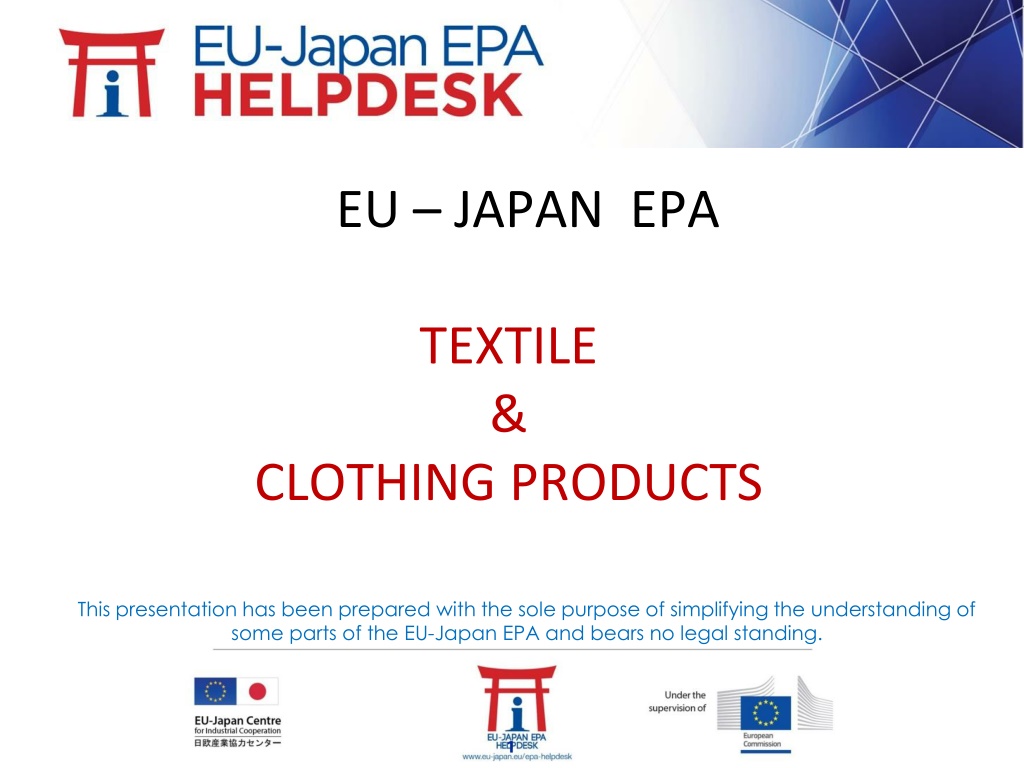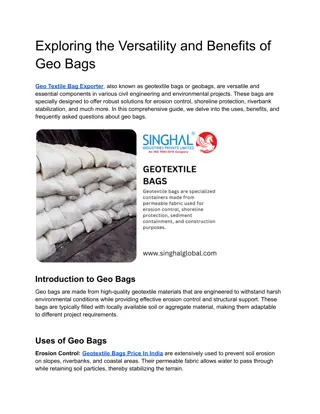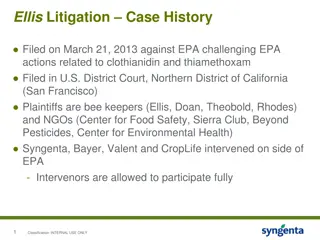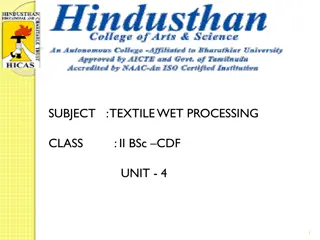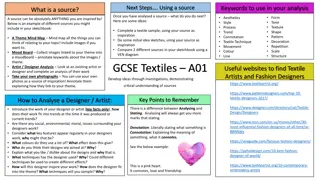Understanding EU-Japan EPA for Textile & Clothing Products
This presentation simplifies the EU-Japan EPA, detailing market access concessions and examples of EU textile products exported to Japan. It emphasizes the significant liberalization for all textile and clothing products under the agreement, including details on duty-free categories and gradual tariff reduction provisions.
Download Presentation

Please find below an Image/Link to download the presentation.
The content on the website is provided AS IS for your information and personal use only. It may not be sold, licensed, or shared on other websites without obtaining consent from the author. Download presentation by click this link. If you encounter any issues during the download, it is possible that the publisher has removed the file from their server.
E N D
Presentation Transcript
EU JAPAN EPA TEXTILE & CLOTHING PRODUCTS This presentation has been prepared with the sole purpose of simplifying the understanding of some parts of the EU-Japan EPA and bears no legal standing.
EPA Process INCREASE MARKET SHARE EU PRODUCTS PROMOTION & INFORMATION July 2018 Signature 1/2/2019 Entry into Force Managed by www.eu-japan.eu/epa-helpdesk Under the supervision of
MARKET ACCESS Types of EPA Concessions Type EPA Code Description Japan s base rate is eliminated at the entry into force of the Agreement Most of those tariff lines are not listed in Japan s EPA tariff schedule Gradual elimination of Japan s base rate over a period of time. the zero duty will be applied in subsequent years. Gradual reduction of Japan s base rate to a certain level. The final reduced level will be applied in subsequent years. TRQs allow for one of the above preferences within the limits of an annual import quantity. Immediate Liberalisation A Duty elimination spread over a period B Duty reduction spread over a period R Tariff rate quotas TRQ Tariff lines excluded from any preference Exclusion X Managed by www.eu-japan.eu/epa-helpdesk Under the supervision of
MARKET ACCESS Very high degree of liberalisation for all textile and clothing products - Duty free for all Chapter 51 to 63 products - A few examples of EU products exported to Japan: - Japanese Tariff Code 621420200 620342200 511211020 621510010 Product Description MFN Rate 6.6% 9.1% 5.3% (13.4) (10.9) Shawls, scarves, mufflers, mantillas, veils and the like of wool or fine animal hair. Trousers, bib and brace overalls, breeches and shorts, of cotton. Woven fabrics of combed wool of combed fine animal hair. Ties, bow ties and cravats, with outer surface of silk only Jerseys, pullovers, cardigans, waistcoats and similar articles, knitted or crocheted, of wool. Nonwovens, whether or not impregnated, coated, covered or laminated. Men s or boy s shirts, of cotton Overcoats, raincoats, car-coats, capes, cloaks and similar articles, of wool or fine animal hair, not containing furskin. Overcoats, raincoats, car-coats, capes, cloaks and similar articles, of cotton, not containing furskin. Women overcoats, raincoats, car-coats, capes, cloaks and similar articles, of cotton, not containing furskin. Men s or boy s overcoats, raincoats, car-coats, capes, cloaks and similar articles: of man-made fibres, not containing furskin. Women s dresses, of other textile materials, not containing furskin 611011010 560312290 620520000 4.3% 7.4% 9.1% 620211200 9.1% 620311200 9.1% 620213200 9.1% 620193200 620449200 9.1% Managed by www.eu-japan.eu/epa-helpdesk Under the supervision of
MARKET ACCESS Silk products (Chapter 50) - all tariff lines have been liberalised at the EIF of the Agreement, - or were already free at MFN basis, - except for the below listed products, which will be liberalised in 10 or 12 years: Jap. Code Label MFN Duty EPA Duty 2020 Duty Free 500100.090 Silk worm cocoons suitable for reeling 2523.64 Yen/kg 1834.91 Yen/kg as from 2028 500200.221 Raw silk (not thrown), other than wild silk, double cocoons silk 6978 Yen/kg 5074.91 Yen/kg as from 2028 500200.225 Raw silk (not thrown), other than wild silk, other than double cocoons silk, 20/22 denier 6978 Yen/kg 5074.91 Yen/kg as from 2028 500200.226 Raw silk (not thrown), other than wild silk, other than double cocoons silk, 20/29 denier 6978 Yen/kg 5367.69 Yen/kg as from 2030 500200.227 Raw silk (not thrown), other than wild silk, double cocoons silk, other 6978 Yen/kg 5074.91 Yen/kg as from 2028 Managed by www.eu-japan.eu/epa-helpdesk Under the supervision of
RULES OF ORIGIN GENERALITIES to benefit from an EPA preference: product must be originating in the EU or Japan. - - to be originating the product must comply with: the provisions Rules of Origin of the EPA text (Chapter 3), including: - conditions to be originating - provisions regarding cumulation, tolerances etc., - the Product Specific Rules (PSR) for each product (Annexes 3A/3B and Appendix 3- B-1): further requirements in order to be originating. These requirements can include: - a change in tariff classification - a production process - a maximum value of non-originating materials - a minimum regional value content - the EPA allows for Bilateral Cumulation: if a product qualifying as originating in one Party, it is considered as originating in the other Party if that product is used as material in the production of another product in the other Party. - - Managed by www.eu-japan.eu/epa-helpdesk Under the supervision of
RULES OF ORIGIN Specific Rules for Textile Products (PSR) a majority of PSR for textile products are based on production processes. the basic principle applicable is the double transformation . Examples Woven fabrics of silk or of silk waste (HS50.07) spinning of natural or man-made staple fibres combined with weaving, or extrusion of man-made filament yarn combined with weaving, or twisting or any mechanical operation combined with weaving, or weaving combined with dyeing, or yarn dyeing combined with weaving, or weaving combined with printing; or printing (as standalone operation). Managed by www.eu-japan.eu/epa-helpdesk Under the supervision of
RULES OF ORIGIN Specific Rules for Textile Products (PSR) More examples Silk Yarn (HS 50.04 50.05) spinning of natural fibres, or extrusion of man-made continuous filament combined with spinning, or extrusion of man-made continuous filament combined with twisting, or twisting combined with any mechanical operation Fabrics (HS 52.08 52.12) spinning of natural or man-made staple fibres combined with weaving, or extrusion of man-made filament yarn combined with weaving, or twisting of any mechanical operation combined with weaving, or weaving combined with dyeing or with coating or with laminating, or yarn dyeing combined with weaving, or weaving combined with printing, or printing (as standalone operation). Managed by www.eu-japan.eu/epa-helpdesk Under the supervision of
RULES OF ORIGIN Specific Rules for Textile Products (PSR) Articles of apparel (HS ex62.01) weaving combined with making-up including cutting of fabric, or making-up including cutting preceded by printing as standalone operation Managed by www.eu-japan.eu/epa-helpdesk Under the supervision of
INFORMATION SOURCES EPA text and Annexes: http://trade.ec.europa.eu/doclib/press/index.cf m?id=1684 Of which: Annex 2-A: Schedule and Notes (TRQ, etc); Annex 3-B: Product specific rules of origin; Annex 14-B: GIs. Managed by www.eu-japan.eu/epa-helpdesk Under the supervision of
INFORMATION SOURCES EPA Helpdesk: https://www.eu-japan.eu/epa- helpdesk Fiches per sectors and webinars on EPA outcome 9 April 19 7 May 19 21 May 19 11 June 19 18 June 19 25 Feb 20 10 Mar 20 Wines and Spirits Geographical Indications Dairy Products Meat Products Processed Agricultural Textile Products Leather Products Managed by www.eu-japan.eu/epa-helpdesk Under the supervision of
INFORMATION SOURCES Overall import conditions in Japan: European Commission DG TRADE Market Access Database : http://madb.europa.eu/madb/indexPubli.htm Japan s Customs: http://www.customs.go.jp/english/c- answer_e/imtsukan/1524_e.htm Managed by www.eu-japan.eu/epa-helpdesk Under the supervision of
INFORMATION SOURCES European Commission (DG TAXUD) Rules of Origin: https://ec.europa.eu/taxation_customs/business/calculat ion-customs-duties/rules-origin_en https://ec.europa.eu/taxation_customs/business/internati onal-affairs/international-customs-cooperation-mutual- administrative-assistance-agreements/japan_en https://ec.europa.eu/taxation_customs/sites/taxation/file s/eu_japan_epa_guidance_claim_verification_denial_en. pdf Managed by www.eu-japan.eu/epa-helpdesk Under the supervision of
Thank you for your attention Yvan VAN EESBEEK Consultant at the EU-Japan Centre for Industrial Cooperation QUESTIONS ? This presentation has been prepared with the sole purpose of simplifying the understanding of some parts of the EU-Japan EPA and bears no legal standing.
